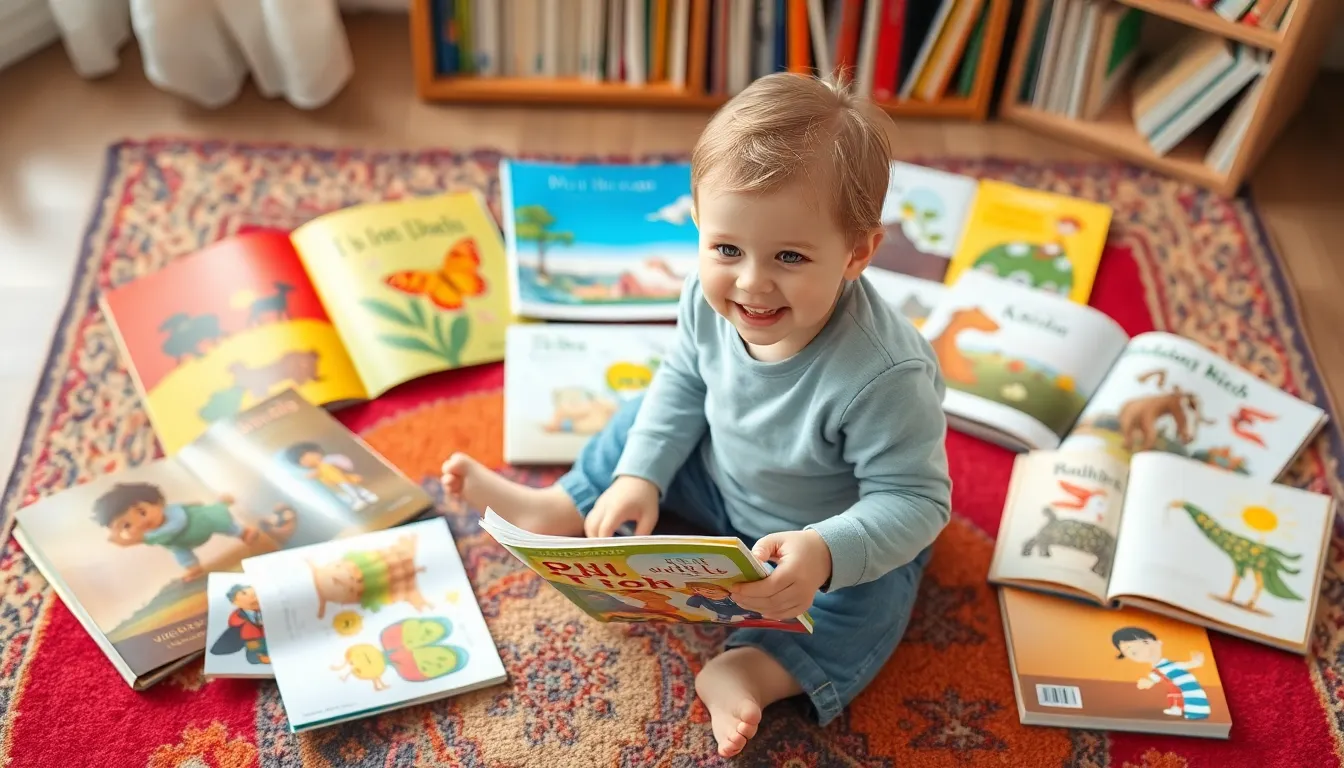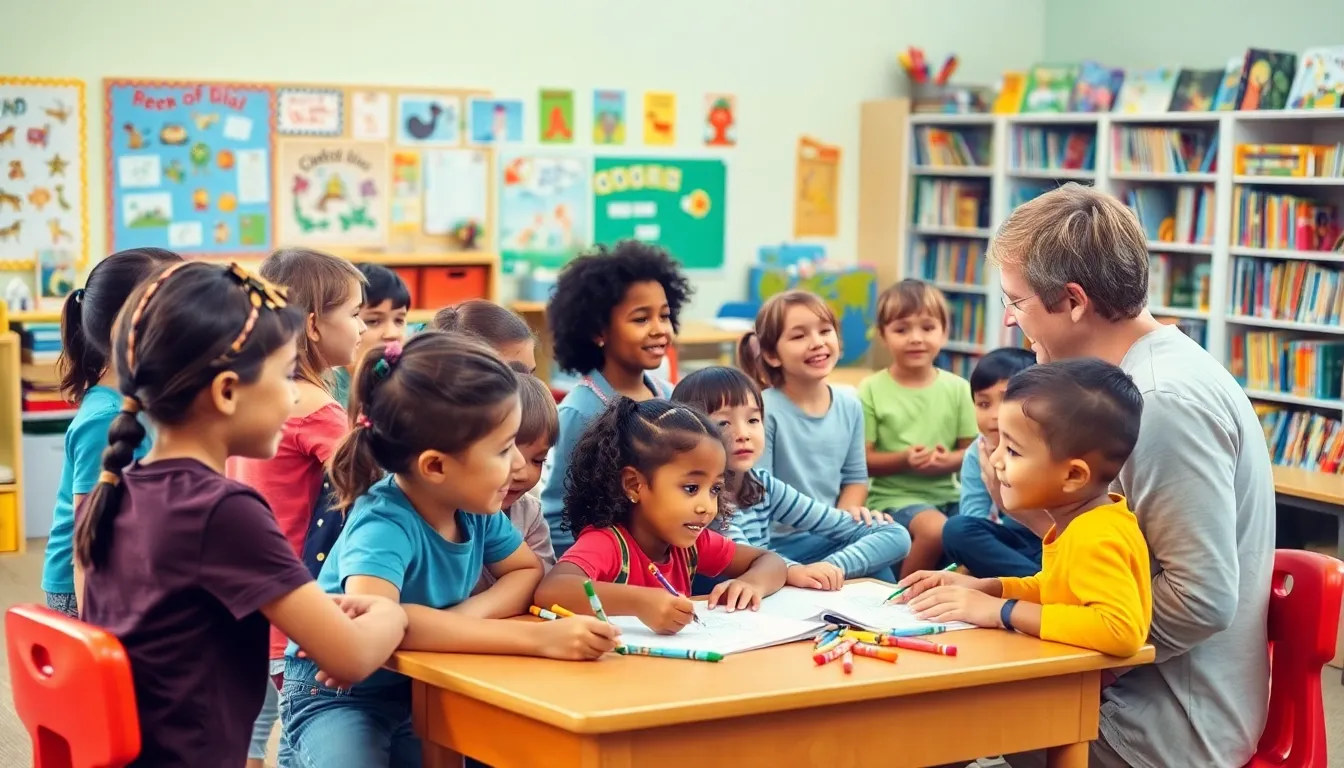Table of Contents
ToggleLiteracy isn’t just about reading and writing; it’s a journey that every child embarks on, filled with twists, turns, and the occasional plot twist worthy of a bestseller. Understanding the stages of literacy development can feel like trying to decipher a secret code, but it’s crucial for parents and educators alike. After all, who wouldn’t want to unlock the mysteries of turning scribbles into Shakespeare?
Overview of Literacy Development Stages
Literacy development stages consist of several key phases that children experience as they become proficient readers and writers. Each stage builds upon the previous one, helping children enhance their skills progressively.
Phase one, known as the emergent literacy stage, occurs from birth to around age five. Children in this stage often engage with books, recognizing letters and sounds while enjoying stories through read-aloud sessions. They may start scribbling and experimenting with letters, forming the foundation for future literacy skills.
Next, the alphabetic stage generally spans ages five to seven. Children in this stage begin to understand the relationship between letters and sounds, allowing them to decode simple words. They often practice basic writing skills, such as writing their names and short sentences, which boosts their confidence.
Following the alphabetic stage, the fluency stage emerges between ages seven and nine. Increased reading practice leads to improved fluency in both reading and writing. Children start reading more complex texts and can write paragraphs with greater coherence.
The final stage, known as the proficient literacy stage, typically begins at age nine and continues into adolescence. In this phase, students analyze and synthesize information from various sources. They can express analytical thoughts in writing, demonstrating mastery of grammar and style.
Understanding these stages empowers parents and educators to support literacy development effectively. Each phase presents unique opportunities for fostering a love of reading and writing, ultimately transforming early scribbles into articulate expressions.
Stage One: Pre-Literacy

Pre-literacy marks the foundation of a child’s literacy journey. This stage spans from birth to around age five, where early experiences with print begin.
Characteristics of Pre-Literacy
Children engage with books in various ways, including exploration and observation. They recognize letters and sounds through playful interactions. Scribbles emerge as a form of expression, showcasing their developing fine motor skills. Listening to stories nurtures their understanding of narrative structure, fostering imagination and comprehension. Various activities, such as singing and rhyming, enhance phonemic awareness, vital for future reading success. Engaging with print materials encourages curiosity about written words, setting the stage for literacy growth.
Importance of Pre-Literacy
Pre-literacy skills lay the groundwork for reading and writing success. Recognizing letters and sounds aids in later decoding skills, critical for fluency. Early exposure to books cultivates a love for reading, encouraging lifelong habits. Listening skills gained during this stage contribute to comprehension and vocabulary development. Families play an essential role in providing enriching literacy experiences, fostering a supportive environment for growth. Understanding the significance of pre-literacy equips parents and educators to promote optimal literacy development in young children.
Stage Two: Early Literacy
Early literacy marks a critical phase in a child’s journey toward becoming a proficient reader and writer. This stage typically occurs between ages five and seven, where children transition from recognizing letters and sounds to actively decoding written words.
Skills Acquired in Early Literacy
Phonemic awareness develops as children recognize the sounds within words. Vocabulary expands, allowing for better understanding and expression. Children start to grasp basic punctuation rules, helping them structure sentences. Decoding skills enhance as they learn to sound out simple words. Comprehension skills grow, enabling them to understand stories and relate them to their experiences. Writing abilities improve, with children beginning to form sentences and explore storytelling elements.
Activities to Support Early Literacy
Reading aloud offers children exposure to varied vocabulary and sentence structures. Interactive story time engages children and encourages questions about the plot. Letter games help children associate letters with their sounds while honing recognition skills. Rhyming activities enhance phonemic awareness by highlighting sound patterns. Creating simple books enables kids to practice writing and storytelling. Engaging in letter writing to family members fosters connection and applies literacy skills in a real-world context.
Stage Three: Developing Literacy
This stage marks significant advancements in a child’s reading and writing abilities. Around ages seven to nine, children begin to integrate their understanding of letters, sounds, and words into coherent reading and writing practices.
Advancements in Reading and Writing
Progress in this stage involves reading fluency and comprehension. Children typically read grade-level texts with increased speed and accuracy. They start to explore various genres, enabling them to encounter new themes and writing styles. Writing becomes more structured as they learn to compose paragraphs, expand their ideas, and use vocabulary more effectively. Participation in group discussions about books further enhances their comprehension skills. Seeking to express their thoughts creatively often leads to increased engagement in storytelling.
Role of Phonics in Developing Literacy
Phonics plays a crucial role in helping children decode words. Mastering sound-letter relationships allows them to read unfamiliar words confidently. Instruction in phonics fosters the ability to break down complex words into manageable parts. Many children benefit from explicit phonics instruction, which aids in their reading development. Transitioning from phonics, children begin to recognize sight words, improving their reading fluency. Integrating phonics into daily reading practices builds a solid foundation for lifelong literacy.
Stage Four: Proficient Literacy
Proficient literacy marks a significant milestone in a child’s educational journey. Readers and writers at this stage exhibit advanced abilities to analyze, interpret, and create complex texts.
Attributes of Proficient Readers and Writers
Proficient readers demonstrate critical thinking skills, allowing them to dissect various genres and texts. They engage with material beyond surface meaning and evaluate arguments effectively. Fluency in reading enables them to navigate challenging texts with confidence. Vocabulary is robust, supporting nuanced expression in writing. They compose multifaceted essays and reports, utilizing structured arguments and supporting evidence. Proficient writers also effectively adapt their styles for different audiences, showcasing versatility.
Preparing for Higher-Level Literacy
Preparing for higher-level literacy involves fostering independent thinking and analytical skills. Educational activities should encourage synthesis and evaluation of information from diverse sources. Studying literature facilitates deep discussions, enhancing comprehension and critical analysis. Encouragement of creative writing helps them experiment with ideas and styles. Collaborative projects can further promote skills like teamwork and communication. Building a habit of journaling refines their writing process and reflection skills. The focus shifts toward developing lifelong literacy habits that support continued learning and exploration.
Understanding the stages of literacy development is crucial for nurturing a child’s reading and writing skills. Each phase builds upon the last, creating a solid foundation for future learning. Parents and educators play a vital role in this journey by providing engaging activities and supportive environments.
As children progress from emergent literacy to proficient literacy, they not only develop essential skills but also cultivate a love for reading and writing. This journey is about more than just academics; it’s about fostering independent thinkers and confident communicators. Embracing this process ensures that children are well-equipped for lifelong literacy and learning.




